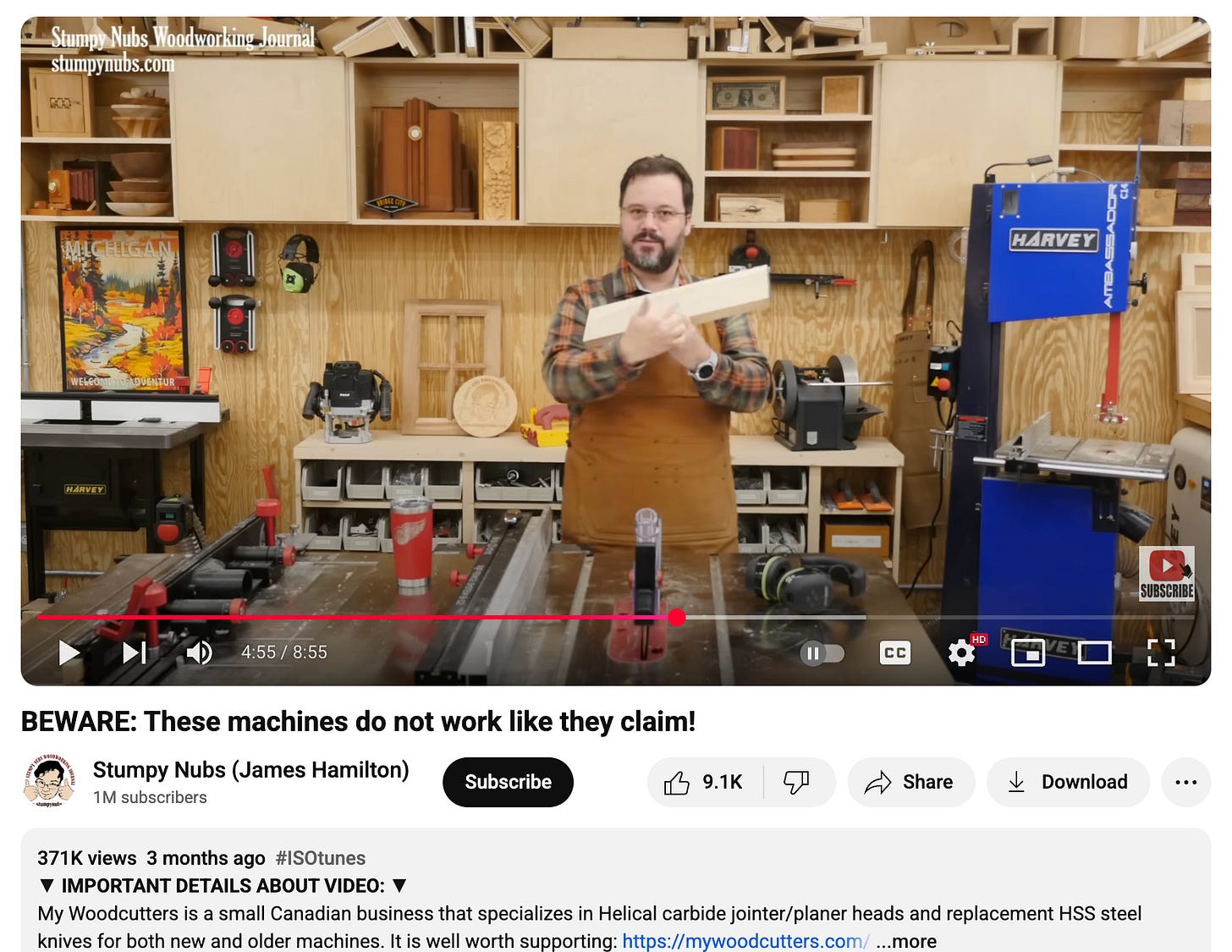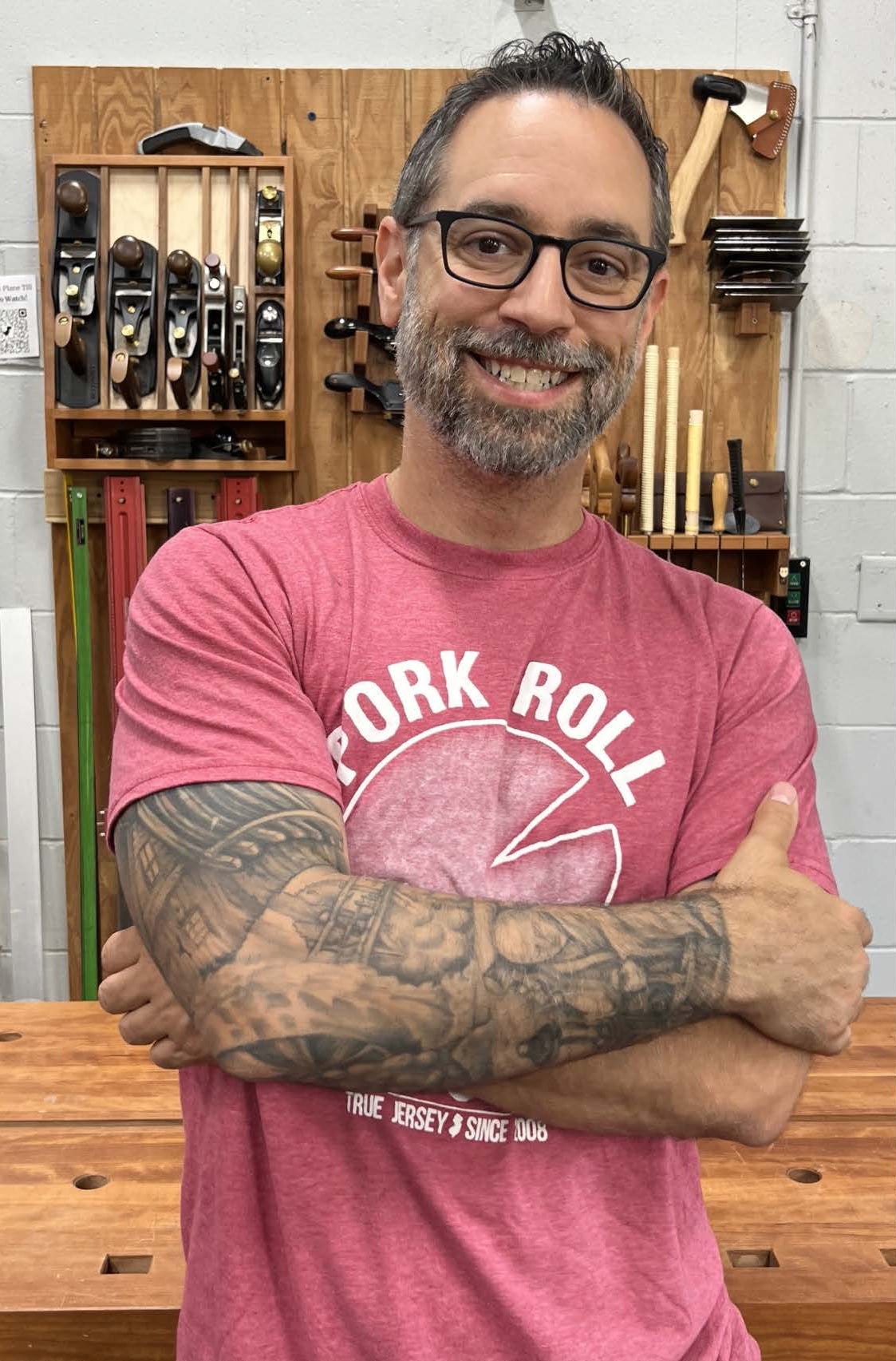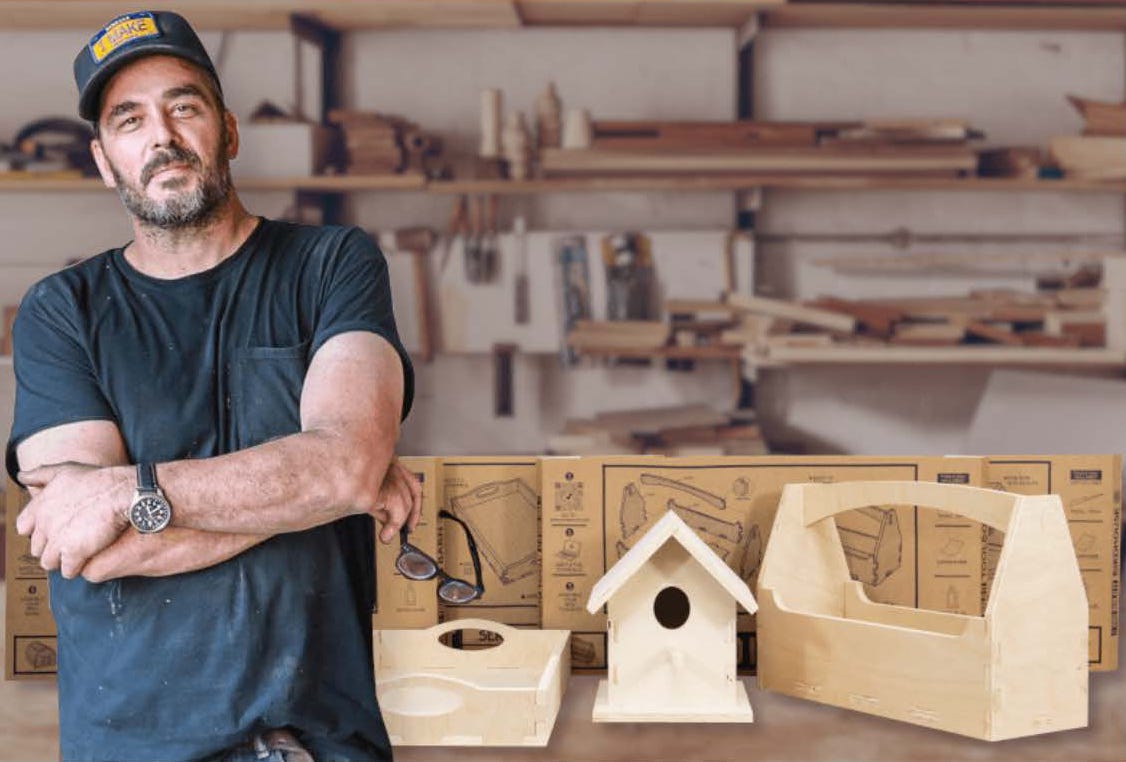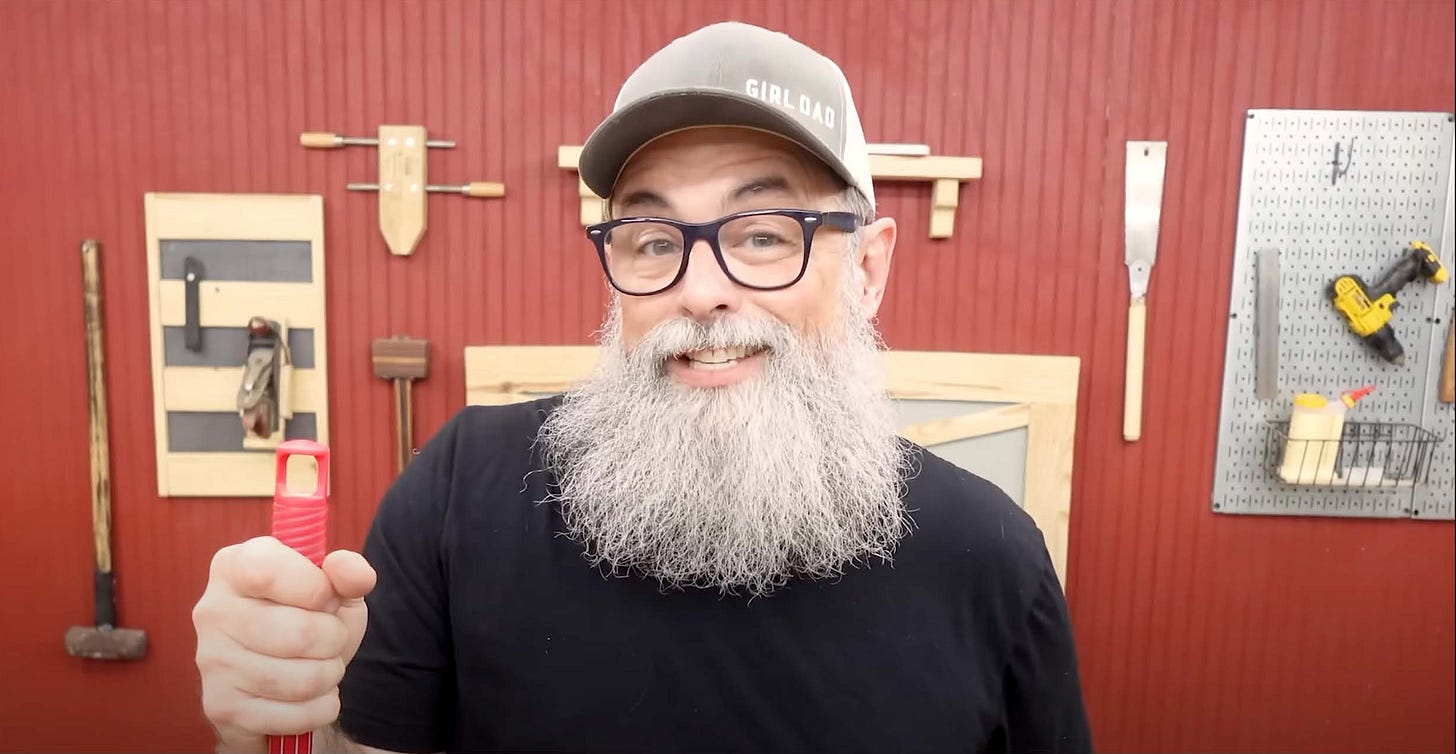Because I regularly crow that we are “never sponsored,” most people assume that I dislike the people who are sponsored. That’s incorrect.
Influencers simply have a different business model than we do at Lost Art Press. Theirs is completely legitimate, honorable and fascinating.
But I don’t think that most woodworkers know how the world of influencers, online sponsorships and affiliate links works. So I asked Kara Gebhart Uhl to interview some of our favorite influencers about their businesses. They were all remarkably forthcoming.
What follows is a three-part series that explains how they make their money. And how they balance ethical questions vs. their reputations with their audience. It’s a fascinating series, and I think you’ll have a bigger appreciation for these content creators as a result.
— Christopher Schwarz
Woodworking Content Creators Part 1: How it Works
Have you ever watched a woodworker on YouTube or Instagram and wondered, How does that world work?
We have. And so we found out.
In part one of this three-part series Anne Briggs (Anne of all Trades), Jimmy Diresta, Jim Hamilton (Stumpy Nubs), Hadeel Khater (Four Rivers Studio), David Morris (Worst Workshop), Marc Spagnuolo (The Wood Whisperer) and Joe Thiele (Boundary Fog Furniture) give us the inside scoop on labels, disclosures and how they make deals with manufacturers.
Sponsorships, Affiliate Programs, Ambassadors –
What Does it All Mean?
“Generally speaking, ‘ambassador’ means you’re getting free product, ‘affiliate’ means you’re getting paid per sale and ‘sponsorship’ means you’re getting paid for the affiliation,” says Anne Briggs of Anne of all Trades.
An “advertisement” is often short-term and a lot like a commercial on TV. When Marc Spagnuolo of The Wood Whisperer reads copy directly from an advertiser and/or shows some footage of their product mid-video one time, he considers that an advertisement. Ads can also allow for more flexibility.
“I wouldn’t call Priority Bikes a sponsor necessarily, but they’re advertising with us for two videos,” Spagnuolo says. “We cut a deal with them. I love cycling. So it was kind of a weird tangential sort of connection, but we made it work. An advertiser is simply buying an ad in whatever form that takes.”
Disclosures
The Federal Trade Commission (FTC) publishes Endorsement Guides with rules content creators must follow, particularly when it comes to disclosure. Content creators use disclosures to let their audience know their relationship to a brand. You can read an FAQ of FTC’s Endorsement Guides here.
“When it comes to anything regarding advertising, disclosure is everything,” Spagnuolo says. “There are companies that when I sign an agreement to do an ad, they actually stipulate what I need to do to disclose it. I must have ‘#ad’ in the writeup. The top line has to say ‘sponsored by’ whatever it is. The companies that are doing it by the rules are the ones making sure their influencers are following a very strict set of guidelines. It’s clear and obvious that there’s a financial motivation for why you’re seeing this particular piece of content. But that doesn’t happen all the time.”
If you think about it from the perspective of an advertiser, Spagnuolo says, what’s going to sell better? An obvious commercial or someone you trust simply wholeheartedly endorsing a product?
“The problem is, one of them is technically illegal,” Spagnuolo says. “So you will have companies who either fly under the radar or they play dumb or they just don’t care. And then you combine that with an influencer or a content creator who likewise doesn’t care and nothing happens. They just simply push a product. You see it all the time. You see something that’s an absolute obvious ad, and there’s no disclosure whatsoever that there’s a relationship between the person and the company.”
But also, Spagnuolo says, fundamentally, he finds some of the disclosures unfair, even though he follows the rules.
“How long have we been watching movies and TV shows and news programs where there are financial relationships, product placements and sponsorships that are never disclosed?” he says. “Hollywood, for instance, is not subject to the same regulations as people like me who are just average Joes making videos online. We’re given more restrictions and have higher expectations on our disclosures than these big, multi-billion-dollar companies.”
Jimmy Diresta says YouTube makes disclosure easy with a button that will inform viewers that the video they’re watching contains sponsored content.
“I often click it when it’s explicit,” he says. “I don’t click it a lot if it’s just brand awareness. But occasionally, when I feel it’s a little heavy advertising, or it might be implied even just through imagery, I’ll click it and it just shows up. Super simple. I do it just to keep my nose clean. God forbid I should besmirch myself on YouTube and get three strikes. I haven’t got any. You get three strikes and then you’re done over there.”
Briggs sees a lot people doing the bare minimum as far as disclosure goes.
“In general, from a legal standpoint, if you’re getting any sort of compensation, you need to disclose that,” Briggs says. “A lot of people don’t. A lot of people don’t want to. And I get that there are actually some legal ways around disclosure. I always try to be overly upfront with people because I don’t ever want to lose trust, but because I understand the legality of things, there are certain things that I don’t talk about because I don’t have to.”
For example, marketing consulting.
“I do consulting for a lot of companies that don’t actually sponsor me,” Briggs says. “They’re paying me to help teach them how to do influencer marketing or they’re paying me to consult on their marketing campaign. When that is the case, it’s possible this or that product they sent me for campaign research might unintentionally show up in some of my content, but am I going to outright, intentionally endorse them? If they’re not paying me to do so, and I’m not disclosing that they are, absolutely not.”
Also, with a shop full of branded product, disclosure can sometimes be difficult.
“In a single sweep of the camera, you might see hundreds of tools, acquired over 14 years, most of which I paid full price for, some of which I received as part of this campaign or that,” Briggs says. “And I do get how, as an ‘influencer,’ one might interpret the possession of a tool to be an unofficial endorsement, making things infinitely murkier, but there’s where I have to trust that my audience uses a little personal discernment. And if anyone ever asks me for an honest review of anything they see in my content, I give it; there are few things I love more than offering critical, use-based feedback, and no amount of money from any company is worth compromising my integrity for. There are, in fact, many partnerships I initially entered into, then later backed out of because their products weren’t up to snuff.”
Spagnuolo agrees that disclosure can sometimes be difficult.
“As much as I’m professing to follow the rules myself, I mess up too,” he says. “You have to be careful.”
Also, specific rules aren’t always clear. For example, Spagnuolo says, say you do 100 videos a year. If a company is a sponsor who provided a free tool, do you have to disclose that every single time you pick up that tool?
“There’s a point where someone comes in, let’s say midyear, and I’ve already talked about the sponsorship,” Spagnuolo says. “I say it at the beginning of every show, but they just started watching. Am I doing a disservice by not telling them this is a sponsored tool in the middle of an episode? That’s where things can get real muddy with sponsorships.”
Jim Hamilton of Stumpy Nubs says he’s witnessed an explosion in affiliate marketing, and with it, issues with disclosure.
“I don’t have a problem with using affiliate links as long as they are properly disclosed,” Hamilton says. “Unfortunately, many channels neglect to make proper disclosures, or worse yet, mislead their viewers about it. A common example is a YouTuber prefacing a tool review with claims of having paid for the tool himself, or having accepted it for free but with no promise of a positive review. I have heard some go so far as to claim ‘no money changed hands.’ Of course, this evidence of their lack of bias is deeply misleading if they are telling you to use an affiliate link to buy the tool after you’ve heard their good review. There is nothing wrong with accepting payment, either directly or through affiliate links, for honest reviews as long as you disclose those things so the audience can take them into consideration when deciding how much weight to give your recommendation. Unfortunately, the general lack of candor among so many channels is straining the credibility of all of us.”
A Closer Look at Sponsorships
Every day, David Morris of Worst Workshop sorts through emails from potential sponsors.
“Some of them may be like a 3D printer – something you really want to work with,” Morris says. “But most of them aren’t things you want to work with. Depending on how many videos you’re going to release a month, you just have to pick the ones you want to work with. There are agencies that work with those brands that basically act as a go-between. … Somebody from there will contact me when a brand wants to work with me, and they may offer a three- to six-video deal, which is great because that means I have six videos that I don’t have to worry about finding a sponsor for – I’ve already got it lined up. However, when you’re small and you’re growing, that may not be something you want to do because what you’re worth now isn’t necessarily the same thing you’re going to be worth in three to six months – you may be worth a lot more.”
Hamilton also says that most YouTube channels get their sponsorships deals through agencies.
“Once you build even a small following, agencies flood your inbox with ‘opportunities’ from all sorts of companies,” Hamilton says. “The problem is, few of the products are relevant to your audience, and you can’t know if the products are worth recommending without already having used them in your shop. Agency contracts also typically require you to give the brand way too much control over what you say about their products. It’s a broken system that floods YouTube with questionable products and disingenuous reviews, in my opinion.”
Hamilton came up before agencies, so he says he never got into that world.
“I met my first sponsors at woodworking shows or because I decided to contact a brand whose products I enjoyed using,” Hamilton says. “I have stuck to that model, skipping the agencies and working directly with companies that I hand pick. I also tend to stick with brands I work with, spending time getting to know the people and building long-term relationships. I think that serves my audience better than jumping from product to product based upon whatever contract an agency is pushing. While I do work with a handful of larger companies, I prioritize smaller, family-based businesses because that’s where I came from. … I have found this model to be much more satisfying than chasing the big deals and the big problems that come with them.”
For a long time, Briggs didn’t rely heavily on sponsorships, and she treated any money she made from them not as income but rather as an investment in her business – a way to give back to her audience. When her husband, Adam, quit his job and joined Briggs in her business full-time, he encouraged more sponsorships.
“Full, honest disclosure, we get a lot more income from sponsorships now than we ever did before,” Briggs says. “I’m doing a lot less marketing consulting, multi-platform posting and paid online courses and leaning a lot more heavily into growing our YouTube channel these days, mostly due to shifting priorities as a family and with our business. As we welcomed our first child, we needed Adam to be able to carry more of the business for a season, and his expertise is in creating longform content, not in marketing or small business consulting. And that shift sometimes feels icky and scary. But he was right in that the YouTube iron was very hot, and consolidating focus is rarely a bad idea, especially if you’re intentional about how you do so.”
For years, Briggs told consulting clients not to build a business solely around sponsorships and reliance on clicks.
“Because you can’t control other people’s choices.’” Briggs says. “You can’t control the platform and how it shows its content. However, on the other side of that, everyone who comes to me and says, ‘No one’s watching my content anymore, and I’ve been shadowbanned or the algorithm changed,’ I’m like, ‘Nope, you’re making bad content, or you’re not optimizing your content for the platform or the viewer that’s there.”
There are a lot of factors at play.
While shifting to a model that relied more heavily on sponsorships, Briggs and her husband were “still super picky,” she says, partnering only with people and companies Briggs has worked with for a long time, often as an influencer marketing consultant and coach. These organic relationships have also allowed her to charge high rates. It’s a pivot that’s paid off.
As someone who is interested in sponsorships, Joe Thiele of Boundary Fog Furniture says they seem great, but he wonders what the pressure is like of constantly having to put yourself on camera.
“Most woodworkers aren’t also actors,” Thiele says. “I don’t think it’s as easy as it appears.”
A Closer Look at Affiliate Programs
“For some people, the affiliate stuff is a huge part of their income,” Briggs says. “I have a friend who makes six figures from affiliate sales on her blog every month and that’s great for her. In some ways, I wish I’d jumped on that train earlier, but here’s the funny thing: I really suck at filling out things and remembering passwords and how to log in. So for a very long time, I had a stipulation in my contracts that I would not consider affiliate sales to be part of my compensation for that contract because I knew I myself, and was fully aware that despite best intentions, I would not likely be able to follow through and capitalize on affiliate sales in the same ways I’ve seen so many others so successfully do.”
Knowing that to be true, early on, Briggs also made a business decision that she would not participate in an affiliate program unless the company also sponsored her.
“If you fill out the paperwork for me (which most of my clients now do because they want to track sales that come through my platforms), if you want to manage all that stuff and just give me a link that I can give someone or a discount code, I’m like, I’ll do that, but you’re also going to need to assume the initial ‘audience risk’ and pay me up front, especially if it’s for a one-off advertising campaign,” Briggs says. “I far prefer to work with long-term, repeat customers than to do one-off campaigns. It’s better for the company, and it’s better for maintaining trust and continuity with my audience. If affiliate sales go really well, we not only have evidence the campaign was fruitful on both sides, we are also more than happy to adjust future sponsorship rates accordingly.”
One of her more successful affiliate programs is with a company that both sponsors her YouTube channel and pays her for marketing consulting.
“That company is someone I approached,” Briggs says. “They didn’t work with influencers before and I was like, ‘Hey, this is what I can bring to the table. You need it.’ And I love this company. I believe in them. I used their products for 10 years before the thought ever even occurred to me to approach them for anything beyond offering occasional product feedback and marketing advice. And the funny thing is, the only reason the thought to ask whether they’d like to sponsor my YouTube channel ever even occurred to me is because one of their competitors reached out with what, at the time, seemed an insane dollar offer for a one-off campaign. I was like, ‘Oh.’ And so I called up the marketing department and was like, ‘Hey, this other company is offering me a very large amount of money to work with them for a one-off campaign. Would you guys want to work with me long-term instead?’ And they said, yes.”
This particular company also offered to fill out all those pesky affiliate forms for her.
“I actually now make a considerable amount of money every month from their affiliate program,” Briggs says. “And not because I’m obligated to talk about them because of specific terms in our sponsorship agreement, but because I genuinely do love their products. I talk about the company a lot and it’s actually of my audience’s benefit to use my affiliate links. They get a discount for using it. And so it’s generating a fairly significant amount of money as well as ongoing proof, both for us as a business, and for their marketing department, that this long-term partnership is a good investment of time, energy and resources. And looking at those numbers, it’s easy for me to be like, ‘Oh, man, I really missed the boat on all this affiliate stuff.’ But was it really a missed boat? As business owners, it’s really important to know ourselves. We all have finite time, energy and capacity, and I opted long ago to lean into my strengths, to make more/better content, to build audience trust and to use my limited time, energy and capacity on those things instead, and I think those things are starting to pay off big time now.”
Spagnuolo says there’s good money to be had from affiliate programs, especially if you work with small manufacturers who have more room to play.
“A 20 percent affiliate cut of an $8,000 laser can get pretty substantial,” Spagnuolo says. “When you’re up at 20 percent, you’re talking about a high-dollar item that can bring in a decent amount of revenue for everybody. But if you’re talking about a program like Amazon, they’ve slowly but surely chipped away at the percentages and the percentages keep dropping.”
Spagnuolo, though, has been in the content creator game for a long time. Affiliate links are buried throughout all his old videos and articles, so even when some of his affiliate links are worth pennies, they add up.
“The cumulative effect of that many affiliate fees over time means that Amazon for us is actually still incredibly important and a viable part of our income stream,” Spagnuolo says. “But here's the problem: They could end it at any point. If they decide they don’t want us in the program, we can get kicked out.”
Morris uses Amazon affiliate links as well.
“A larger platform like Amazon isn’t asking me for any space [meaning time spent during his video talking about a product],” Morris says. “I can just put something in my description about the tools that I’m using or the products that I’ve used to build whatever I’m building. And I get a little bit of money from that. I don't get a lot of money. But I know guys that have channels my size that they get $3,000 a month from just Amazon affiliate sales. That’s pretty solid.”
Unlike Amazon, with companies like Woodcraft or Rockler, for example, Spagnuolo says you have to have their permission to promote their product via an affiliate link.
“That company is not a sponsor,” Spagnuolo says. “They’re not an advertiser, but I may do an advertisement because I need people to know about the affiliate link in order for me to make revenue from it. That’s where things can get real tricky. Decisions have to be made.”
For example, say a company contacts you on social media, Spagnuolo says. They say they’d love to send you their product and set you up with their affiliate program.
“They’re not going to pay me, but they’re literally asking me to do an ad, and then my payment comes when sales come in and I just get a cut of the sale,” he says. “So depending on a person’s audience size, depending on how desperate they are to try to make a few bucks, you could find a whole range of relationships and how these affiliate programs are being run by each individual depending on what they’re trying to get out of it.”
For people who are just starting out, this can get messy, especially if they’re inclined to say yes to everything, Spagnuolo says. The more a product is mentioned, the more it’s going to sell, which may turn into a less-than-honest push of a product they don’t have much experience with.
“I think affiliate marketing puts the most emphasis on an individual’s level of ethics and morality,” Spagnuolo says.
Diresta prefers self-promotion over affiliate links.
“If I’m going to promote anything, I’m going to promote my own website,” Diresta says. “Anytime I talk about my products and my leather, it sells. Anytime I talk about somebody else’s stuff, people might go look and then be like, ‘Eh, I don’t need a magic angle finder.’ So I think people will always be more apt to buy things from me personally. But there are guys out there that just push affiliate links all the time. The Amazon affiliate program is very successful for a lot of people. It’s never been for me but somehow, oddly, I get an $85 check from Amazon every month. I have no idea why.”
Diresta says he knows people who get up to $5,000 checks from Amazon each month because everything they use in their videos has an affiliate link associated with it.
“I could certainly do that,” Diresta says. “I’m a little bit lazy in that regard. I just say, ‘Hey, today I made a stool, go look, this is where I made it, and this is the featured product I used.’ I could go in there and say these are the sneakers I wore, these are the pants I wore, and then put an affiliate link for everything. I just don’t have the bandwidth to do that. I’m really more just focused on the artistry of it all. I obviously do need to make a living, but when it comes down to the bigger guys and they want to do an affiliate link, I say, ‘Just pay me.’”
Keep reading with a 7-day free trial
Subscribe to The American Peasant to keep reading this post and get 7 days of free access to the full post archives.












